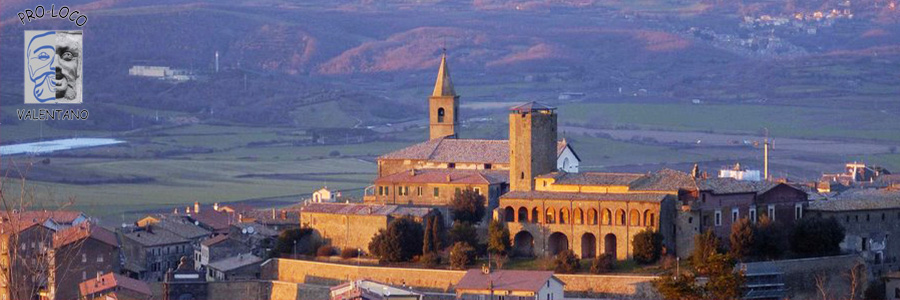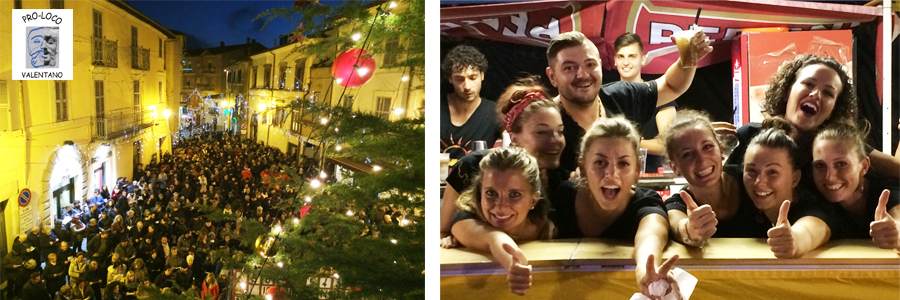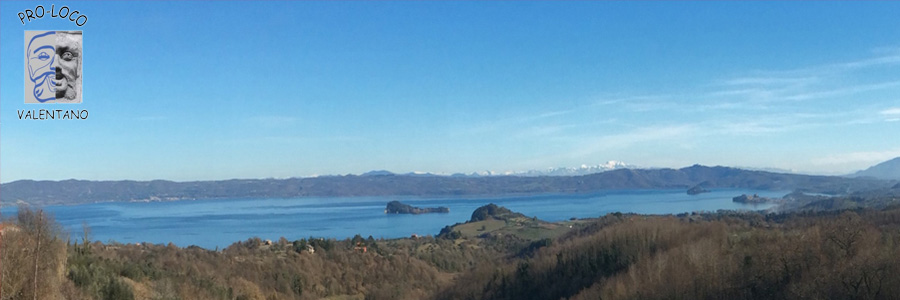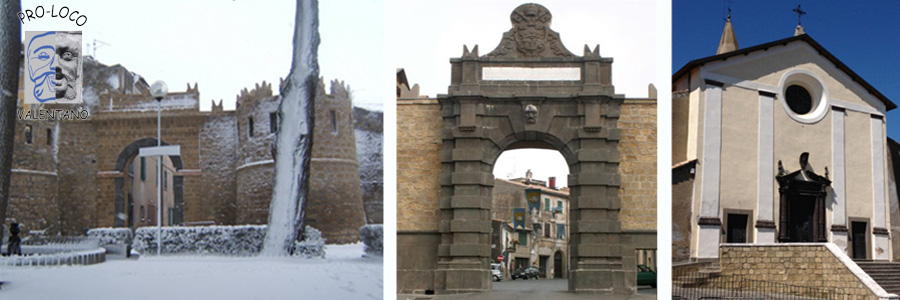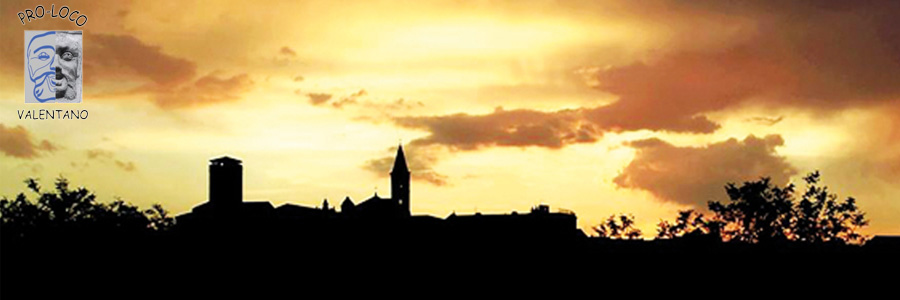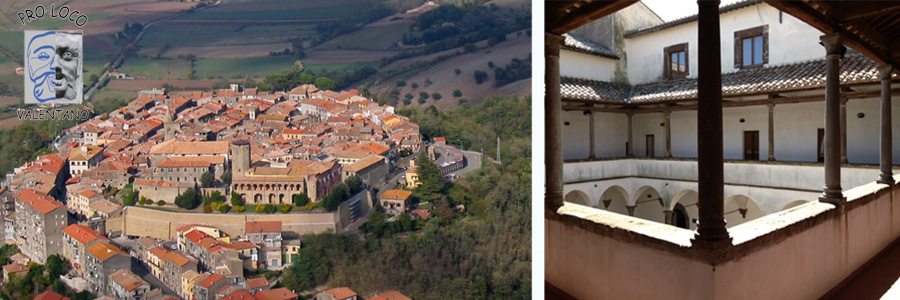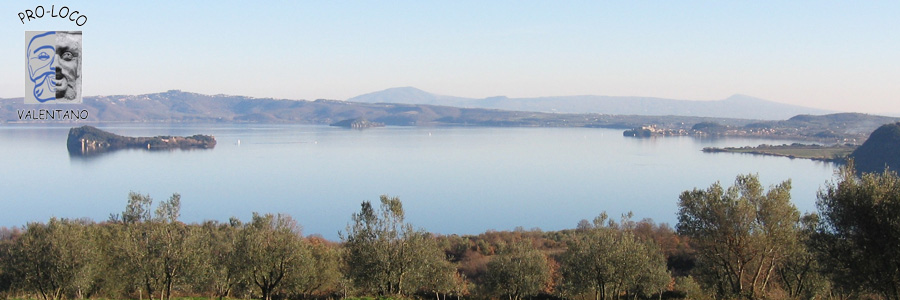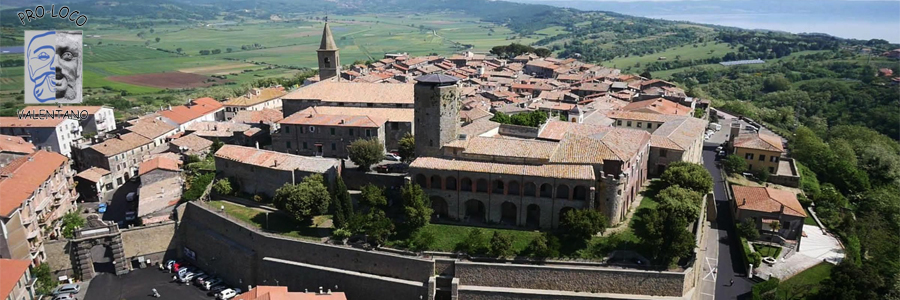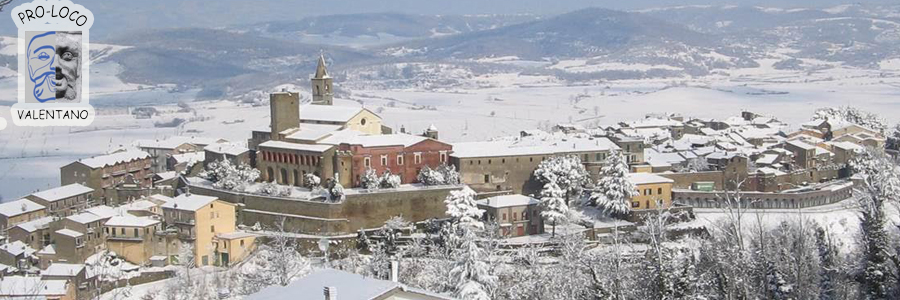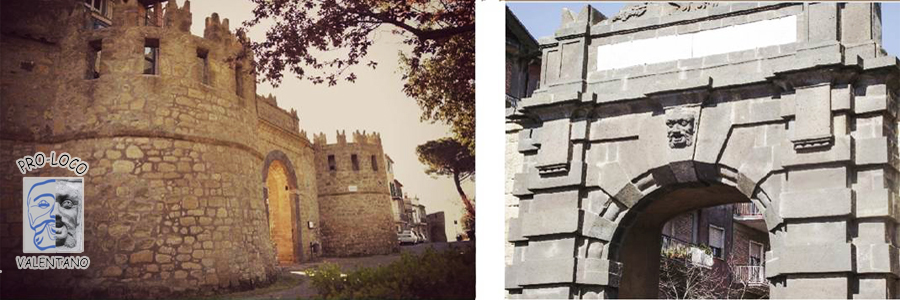Historical-artistic-monumental heritage
“Al di fuori del sogno, il passato, in realtà, non ricompare tale e quale; anzi, tutto sembra indicare che esso non si conserva, ma che lo si ricostruisce a partire dal presente”.
The historical center and the Town Hall
The old town of Valentano is centered around Cavour and Paolo Ruffini squares, where a couple of straight roads (Santa Maria, Via di Mezzo) departs from, and from which you can walk through Via Trento ("La Selciata") up to the Church and the Rocca Farnese.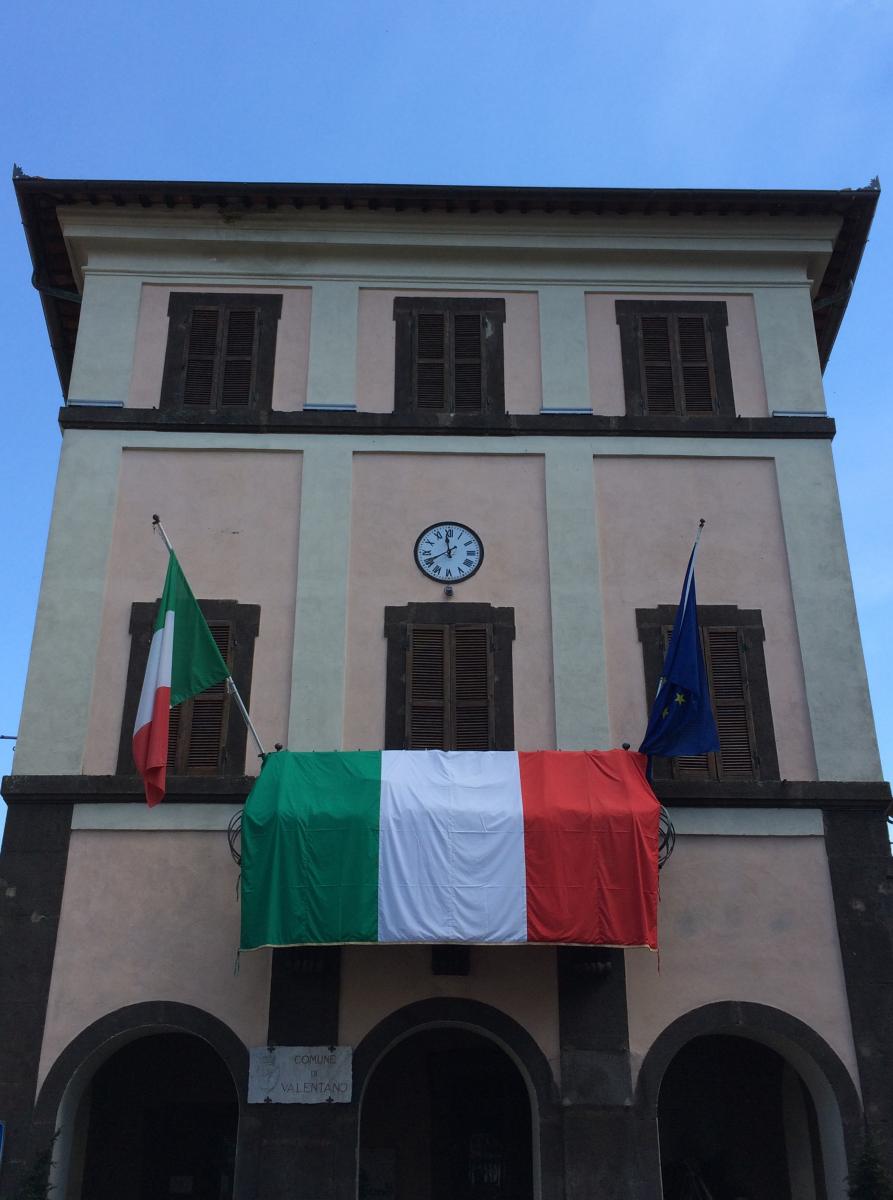
The Valentano Municipality was established at 1552, and the original building consisted of a lower porch and at first floor. At the beginning of 1700 the Palace itself was enlarged, also to accommodate the courts that had been transferred to this center after the destruction of Castro.
The ground floor loggia, topped by an artistic balcony with wrought iron railing of the century. XVII, is now home to several important historical sites: the coat of arms of 1400 coming from the Acquaiela fountain (a high-medieval period that marked a cold water source), the coat of arms of Pope Martin V Colonna joined the Farnese shields (inserted in the front door access to the town in 1417), one fifteenth Farnese coat of arms with the traditional six lilies, the coat of arms of Pope Paul III Pope (Alessandro Farnese) elected in 1534 and died in 1549. a plaque in memory and memory of Giuseppe Garibaldi (1910) and so-called "Tombstone of the Fallen" erected in memory of the soldiers of Valentano perished in the First World War and the text of which was entrusted to the famous man of letters Fausto Salvatori, author of the known "Ode to Rome."
The "bushel" (measure of stone capacity) and "cane castrense" (linear measurement of the Duchy of Castro) once placed under this portico, are now preserved in the Medieval section, Renaissance and Modern Art of the Civic Museum.
Porta Magenta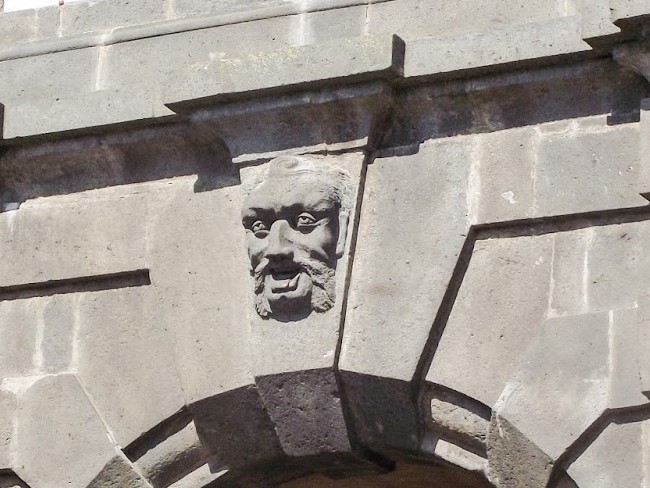
Piazza Paolo Ruffini ends with the Porta Magenta, important monument built in 1779 and designed by Vignola, replacing the ancient Porta Romana, which collapsed in 1774.
Outside the arc, to the top of the vault, there is the famous "Mask".
Tradition has it that the artist, annoyed by the constant cues from the crowd of the curious, wanted to so stigmatize some local "tongue".
The Fortress
According to historical records known the Valentano Castle was built as a defensive structure, around 1053. One may think that at that time a city wall enclose with a strong tower, the church dedicated to St. John and the first houses.
The war between Orvieto and Viterbo led to a series of destructions and reconstructions of the castle up to the fire, in 1252, according to tradition, burned part of the country that was saved from Sant'Agata, patron from fires.
The Valentano Castle, from the octagonal tower, was rebuilt in 1296, on pre-existing medieval defensive constructions.
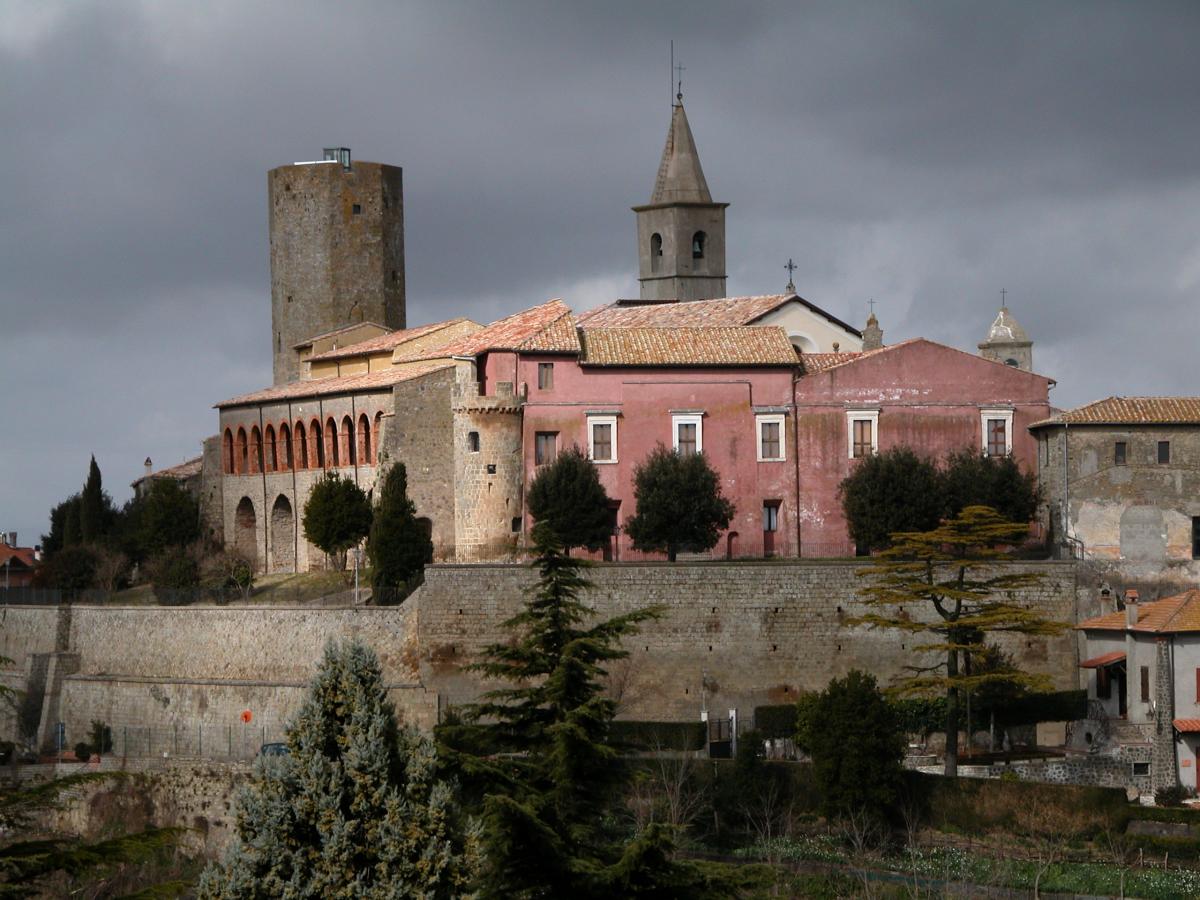 In 1327, under Louis of Bavaria, the country and the walls of Valentano suffered severe damage and even damage were caused by the troops of the prefect Giovanni Di Vico Viterbo in 1350.
In 1327, under Louis of Bavaria, the country and the walls of Valentano suffered severe damage and even damage were caused by the troops of the prefect Giovanni Di Vico Viterbo in 1350.
Years of peace for our Castle began with the arrival of the Farnese who took possession of the castle in 1354, at the time of the cardinal Albornoz, during the presence of the Popes in Avignon. Subsequently they became Lords of Valentano and other neighboring towns.
The castle was inhabited by the Farnese in more assiduous way in around 1400 when it was restored a part of the monument and built the round tower, located to the east. Still other work was carried out towards the end of 1400 when he made the courtyard of love for the marriage of Angelo, son of Pier Luigi the Elder and Lella Orsini of Pitigliano, celebrated in 1488. The fine capitals are the work of a certain Lorenzo, stonemason of Florence. The courtyard is about this marriage through the union of the coats of arms of the two families and the allegory of the flowering of the Farnese lily that appears on the lower colonnade capitals.
Later, other changes took place at the time of the wedding of Pier Luigi Farnese, junior, with Gerolama Orsini in 1519, with speeches by Antonio da Sangallo the Younger (as it appears in the real travertine instead pit of a place side of the courtyard, in some elements such as portals, window jambs, and especially in the monumental fireplace placed in the top "Sala Ducale"). These were the best years of the life of the castle because you were born important people such as Alexander and Ranuccio, future cardinals, the Ottavio dukes and Horace and Victoria, Duchess of Urbino.
In 1534 Alessandro Farnese was elected Pope with the name of Paul III. It was he who wanted to build the large loggia, with eleven upper arches, tufa and bricks towards the west, which is why it's called the Lodge of Paul III.
Pier Luigi, in 1537, became Duke of Castro and, in 1545, of Parma and Piacenza.
The castle was still inhabited by the Duchess Gerolama Orsini and his son the Cardinal Alessandro Farnese, who built a big staircase frescoed to come up to their apartments.
The Farnese were forced to abandon the Valentano Castle in 1649, after the war with the Papal States and the destruction of Castro, capital of the Duchy.
The monument was first used as a granary and the Community prisons and, therefore, used since 1731 in the Monastery of the Dominican Sisters who transformed the castle into various parts and, above all, they built a Holy Stairs in ancient stairway by Alessandro Farnese.
During the wing of the Castle Risorgimento housed a garrison of Zouaves, French soldiers sent to Valentano by Pius IX to fight Garibaldi (1867-1870).
When, around 1930, the Sisters of the Monastery were transferred to Gubbio, the City destined the castle to house the elementary schools and then some circles were used as dwellings.
The castle, abandoned in 1957, was restored in 1979.
Today it houses the library (since 1989) and the Museum of Prehistory of Tuscia and Farnese Rocca, opened in 1996.
The Collegiate Church of St. John the Evangelist
Built around 1000 in Romanesque style, the church, dedicated to the Apostle St. John the Evangelist, has been restored several times up to present itself in its current state, with reconstructed facade around the middle of the century. XV with the placement of the card badges. Alessandro Farnese, junior, (Valentano 1520-Rome 1589), the Bishop of Montefiascone (Card. Bentivoglio) and the Community of Valentano (image of St. John the Evangelist, which preceded the other coat of arms with the alder tree emblem). 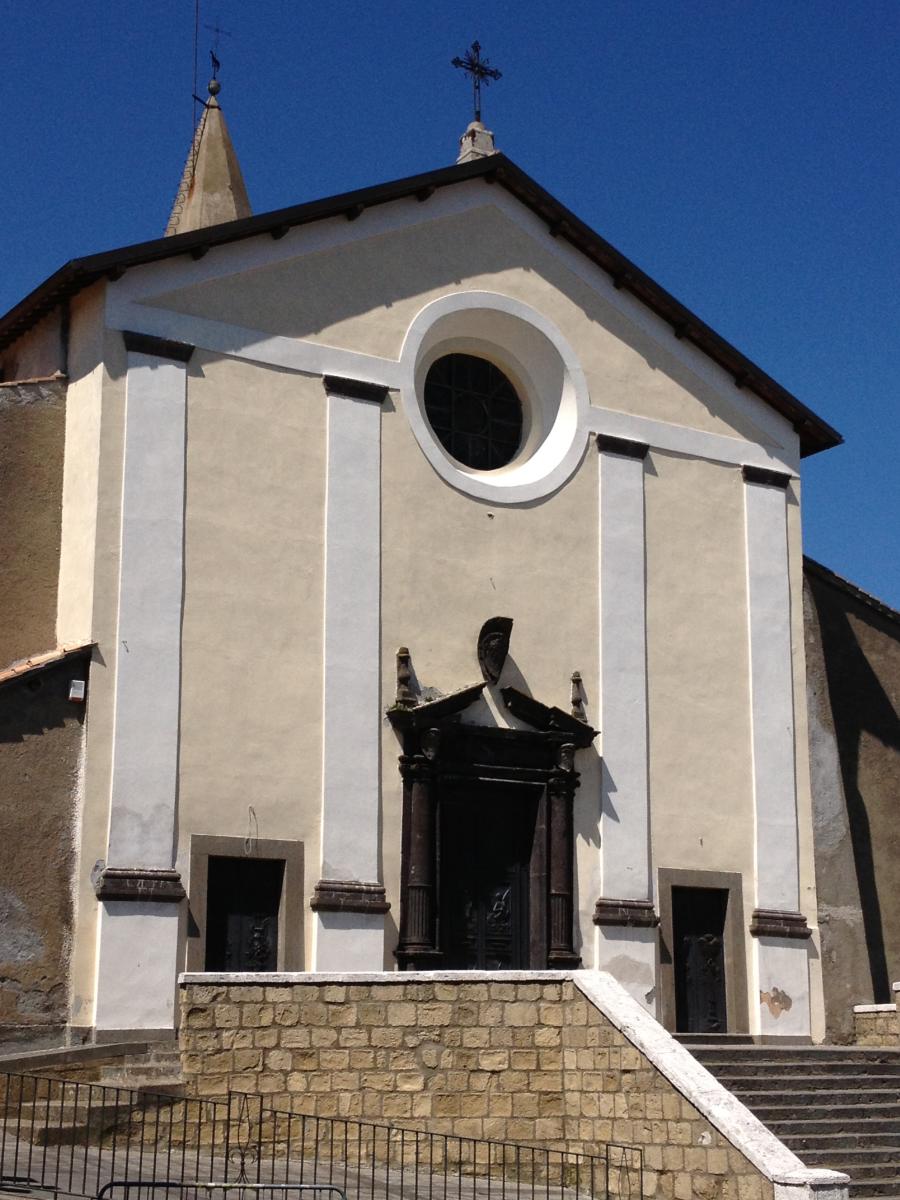
The title of parish, removed homonym church placed outside the walls, was applied to this sacred building in 1253 by order of Pope Innocent IV.
The interior presents itself in all its splendor "Baroque", as it wanted to transform the ancient monument, between late 1600 and early 1700. Of the previous interventions you saved a valuable fresco of the Crucifixion attribute Marcello Venusti . Of the mid-century. XVII is the fine wooden statue of the Madonna Assunta donated to the church by the priest U.K. Lazzari.
Other splendid paintings are the work of Corrado Giaquinto (Madonna, Child and souls in purgatory), Peter Lucatelli (Madonna of the Rosary with St. Dominic and St. Catherine, 1700). Two paintings dedicated to the patron Saint John are the work of the painter Peter Masters, fine sec. XVIII, painter from Città della Pieve and then abiding in Valentano. Among the other paintings are to be reported to Mattia Alessandro Farnese, by some called the "painter of Valentano" (Madonna with Child and Saints Peter and Paul, from the Church of St. Mary), and another of the painter Francesco Maria Viterbo bonifazi with Saint Francis, Saint Lucia and St. Agatha 1711 (this work in poor condition).
Under the main altar is preserved the artistic urn containing the relics of the patron Justin Martyr, Saint by name imposed.
The Church of Santa Maria
Located along the homonymous street (now Via Matteotti) the Church, whose origins are ancient, so it can be fixed at least to sec. XV, has been completely transformed today because originally oriented toward the north, at the time of the Farnese (ca. 1520) was oriented towards the east to align the entrance along the new Via Santa Maria, traced and built by Pier Luigi Farnese, junior. Today, it is according to the restructuring carried out from 1736 to 1744 on the initiative of the priest Pietro Amari.
There is a beautiful fresco with the image of the "Madonna della Rosa", of which you do not know the author but which appears as one of the primitive sacred images venerated in the Church. Important today are the reconstructed wooden image of Our Lady of the Chaplet (around 1736), an "Ecce Homo" wood of 1700 and an oil painting on the wall of St. Cannucciari with the Crucifixion, 1897.
The Church of Santa Croce
It is one of the oldest churches in the country and there is preserved a valuable fresco of the Umbrian-Sienese school, the mid-century. XV. This is the Madonna and Child "flagellants" or "flying" a penitential movement active in Umbria since 1200.
The Church, as it appears today, is the renovation of the chapel of "Santa Maria of Flying" took place in the mid-1600s.
The Church of Madonna del Monte
In the high of the Montenero hill overlooking Valentano, it stands the small Church of the Madonna del Monte, or "Our Lady of Mercy", built around 1853.
The small oil painting venerated there, depicting the Madonna with the dead Christ in her arms, the mid-century. XIX, it is preserved in the Collegiate.
The front door of the church is the work of Professor Balestra, local artist whose works are known and appreciated by contemporary art lovers.
The Sanctuary of the Madonna della Salute
The Shrine of Our Lady of Health, which from 1708 was attached to the adjacent convent of the Friars Minor, has for some years the parish in its own right. The right side borders the cemetery, burial place of Valentano dead for several centuries.
Recently the shrine was renovated and reopened after a closure period during which a wing of the Cloister had hosted a small altar.
Note the organ of 1852, now in need of renovation, but still capable of producing profound and expressive sounds in spite of a few problems for the organist.
The late Fr Giorgio De Dominicis, Valentano, several times higher than the Retreat and Keeper of the Sanctuary, on the occasion of the 75th anniversary of the Coronation of Our Lady of Health, published in L'Osservatore Romano of August 23, 1974, CXIV, n. 192, p. 2, a memory of the secular history of the Sanctuary of "Madonna della Salute" in Valentano. Even then it was on the eve of a Holy Year and, therefore, his speech, although distant in time there appears still full and living relevance. Again present in large part because the dear Father Jorge manages to fully emphasize the value of Valentano and its people with the Madonna SS.ma of Health.
The origins of this shrine date back to the second half of the fifteenth century, when the chief bandit Francesco Portici, reduced to impotence for the hunt continues that grew in castrense region, surrendered voluntarily to the authorities and, after a public penance done in the church S. Savino, Cathedral of Castro, he chose as his voluntary exile the rugged wilderness where now stands the Convent. There, he built a crude chapel with stones collected on the site and displayed for veneration a painting of the Virgin and Child in her arms, which was called by the hermit named "Our Lady of the Sniper" (diminutive for Francesco).
When he died, on the close of the century. XV, already the rude hermitage attracted the piety of the faithful, so that his departure imposed the problem of succession. From this moment the shrine had many twists and turns, now glad now sad, of splendor and abandonment.
A period of splendor was certainly when, in 1506, some religious order of St. Augustine, who at that time lived in nearby Martana Island, took possession of the Sanctuary and the place of the primitive and little hermitage, built a church and an altar dedicated to 'Our Lady of Health. "this is the first official title given to the Sanctuary, even if, for two centuries, it was called" Santa Maria della Rosa "(when in 1582/83, through the work of countryman Giovanni Vitozzi, the crude primitive painting was replaced by a statue depicting the Mother of God that gripped between the fingers of his right hand a rose).
The Friars Minor took possession of the Church and Convent of the May 27, 1708, after quite difficult and laborious negotiations, thus closing a long period of uncertainty, anguish and moral distress, and opening a new era with a secure promising future, where the blessing of Our Lady manifested itself clearly, as if to reward the faith, perseverance and tenacity of his devotees.
In all circumstances, sad and painful, the people stood at the foot of the Madonna comfort and health. Whenever looming threat of a public calamity which departed from the population the entreaty of the powerful help. so it was for the famine of 1807, for the plague of 1831, and during the world wars of 1914 and 1940.
Meanwhile, in our convent, which for the particular lives lived here was called 'Withdrawal', under the maternal gaze of the Madonna, they found numerous religious sanctification of oneself
The Church of Annunziata in Villa Fontane
The present church, built in 1927, was dedicated to the Madonna SS. Annunziata and this title is also added to S. Agapito, when the relics of the martyr prenestino and the altarpiece, were brought here with the aggregation (1930) of the rural parish of Bisenzo. The parish church has recently been enriched by Mario Vinci sculptures and with the inclusion of stained glass windows, the work of artists Mario and Chiara Balestra.
In addition to the Annunziata original picture painted by Sister Imelda (1933), in the church is preserved, as said the eighteenth-century altarpiece of S. Agapito, and a valuable seventeenth-century majolica with Madonna and Child recovered in the Piazzetta of Villa delle Fontane.
